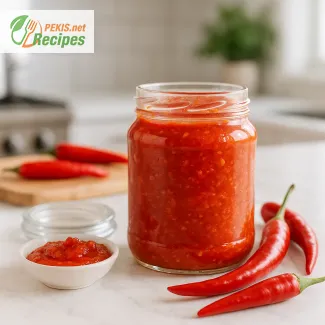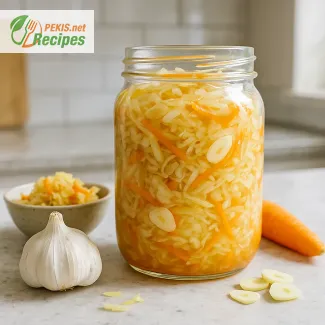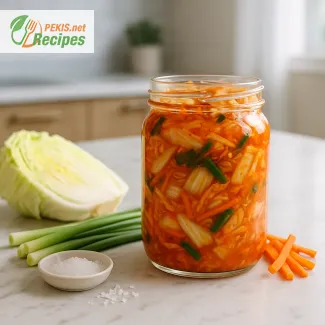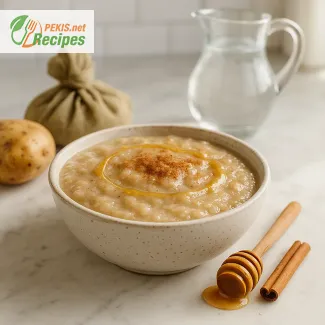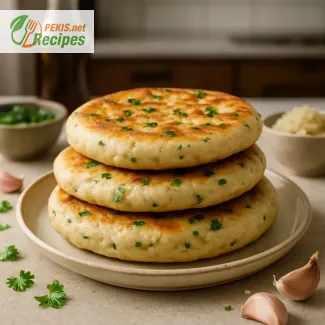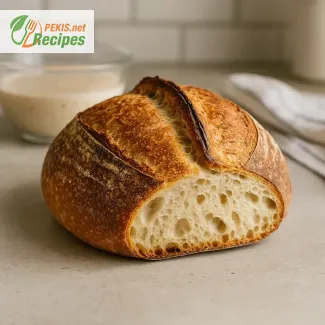Fermented garlic honey delivers a simple yet powerful blend of raw honey and fresh garlic cloves, ready in just 10 minutes of prep with no cooking required. Designed for about 20 servings, this golden tonic develops richer flavor the longer it ferments, transforming from sweet to tangy with soft, mellow garlic. Stored properly, it keeps for months at room temperature, with the option to freeze for 2 months or gently reheat at 150 °C for 8–10 minutes. Its versatility makes it a natural immune-boosting kitchen staple, ideal for drizzling over vegetables, glazing meats, or stirring into warm drinks for a soothing finish.
PEKIS – a professional chef and recipe developer with more than 25 years of experience, specialized in European and international cuisine. Over the years I’ve worked extensively with fermented foods, and fermented garlic honey is one of those preparations I’ve perfected in both traditional kitchens and modern cooking spaces.
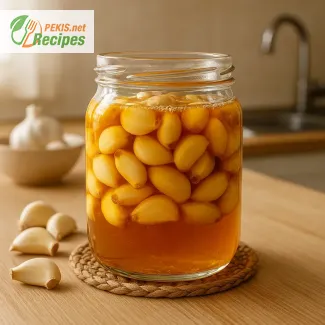
Healing power of fermented garlic honey in everyday cooking
A natural fusion of flavor and wellness
Fermented garlic honey has become a culinary staple that combines both medicinal tradition and everyday kitchen creativity. By submerging fresh garlic cloves in raw honey and allowing them to ferment naturally, the mixture develops into a golden, slightly tangy elixir that balances sweetness with the earthy sharpness of garlic. This combination is celebrated not only for its immune-boosting qualities, but also for the way it transforms basic pantry ingredients into something extraordinary.
The gentle fermentation process enriches honey’s natural enzymes while softening garlic’s pungency, creating a smooth, mellow depth that makes it versatile in both savory and sweet applications. Many home cooks now keep a jar on hand as part of their seasonal remedies, while chefs use it as a gourmet flavor enhancer in marinades, dressings, glazes, and even cocktails.
Origins and traditional background
The concept of fermenting garlic in honey is rooted in ancient folk medicine. For centuries, garlic was valued as a natural antibiotic and honey as a preservative with healing qualities. In Mediterranean kitchens, honey has long been used to preserve fruits and nuts, while garlic found its place in almost every rustic recipe. Combining the two created a remedy passed down through generations as a protective tonic during colder months. Modern food culture has revived this tradition, making it both a health ritual and a culinary adventure.
Why you will love this recipe
- Naturally supports the immune system.
- Adds a unique depth of flavor to everyday meals.
- Easy to prepare and requires only two simple ingredients.
- Long shelf life with minimal effort in storage.
- Fits into both modern cooking and traditional home remedies.
Storage and make-ahead guidance
- Keep at room temperature for up to 2 days during the initial fermentation phase.
- Store in a cool, dark place once the fermentation stabilizes; the flavor will deepen over time.
- Safe for freezing up to 2 months if you prefer longer preservation.
- To reheat for use in sauces or glazes, warm gently to 150 °C for 8–10 minutes without boiling, which protects the delicate enzymes and aroma.
Creative variations with culinary entities
- Citrus-infused version: Add strips of lemon or orange zest to create a refreshing, zesty undertone perfect for salad dressings.
- Herbal fusion: Incorporate sprigs of thyme, rosemary, or sage for a fragrant, Mediterranean-inspired infusion.
- Spicy twist: Slice in fresh chili or ginger to balance the sweetness with a warming kick.
- Smoky accent: Pair with smoked paprika or chipotle for a glaze that elevates roasted meats or grilled vegetables.
- Tea companion: Stir a spoonful into hot herbal tea for a soothing winter drink that doubles as comfort and remedy.
Everyday uses in the kitchen
Fermented garlic honey adapts to multiple cuisines and meal types. Drizzle it over roasted root vegetables to enhance their natural caramelization. Use it as a glaze for baked salmon or chicken, where the honey creates a glossy finish and the garlic adds subtle complexity. In plant-based cooking, it enriches grain bowls and roasted chickpeas, providing both sweetness and depth. For breakfast, swirl it into yogurt or spread over toasted sourdough for a nourishing start to the day.
The balance of taste and wellness
The magic of this preparation lies in its balance. Honey mellows garlic’s strong bite while garlic strengthens honey’s restorative character. As the weeks pass, the mixture becomes smoother, richer, and more complex in taste, proving that patience rewards both the cook and the diner. This makes it a perfect example of how traditional knowledge can be reimagined for today’s kitchens.
- Peel the garlic cloves and ensure they are clean and dry.
- Place the cloves into a sterilized glass jar, leaving some space at the top.
- Pour raw honey over the garlic until fully submerged.
- Close the jar loosely to allow gases to escape during fermentation.
- Store the jar at room temperature away from direct sunlight.
- During the first few days, open the lid briefly to release any built-up gas and stir gently if needed.
- Allow to ferment for at least 2 weeks, preferably 4–6 weeks, until the honey becomes more fluid and garlic softens.
- Once fermented, tighten the lid and store in a cool, dark place.
FAQ questionHow long does fermented garlic honey last?
When stored in a cool, dark place, it can last for several months. The flavor continues to deepen over time, making it even more enjoyable.
FAQ questionCan I eat the garlic cloves or just the honey?
Both can be consumed. The garlic cloves become soft, sweet, and mild, while the honey carries the fermented flavor.
FAQ questionIs it safe to ferment garlic in honey at home?
Yes, as long as the cloves are fully submerged in honey and the jar is kept loosely sealed to allow gases to escape during fermentation.
FAQ questionHow can I use fermented garlic honey in cooking?
It works as a glaze for meats, a drizzle over vegetables, mixed into dressings, or stirred into warm teas for a soothing effect.
FAQ questionCan I substitute honey with another sweetener?
Yes, you can use maple syrup or agave syrup for a vegan-friendly version, though the fermentation process and flavor profile will be slightly different.
Fermented garlic honey brings together the natural sweetness of raw honey and the earthy strength of garlic, creating a preparation that is both practical and deeply flavorful. Its long shelf life and ease of preparation make it a reliable addition to any kitchen, offering both taste and function in a single jar. The gradual transformation during fermentation enhances the honey’s smoothness and mellows the garlic, producing a balanced blend that fits easily into daily routines.
From soothing winter drinks to glossy meat glazes and simple spreads on warm bread, this combination adapts to countless dishes. Beyond its culinary role, it has become a trusted immune-boosting staple, appreciated for its depth of flavor and versatility. The harmony of honey and garlic ensures that every spoonful delivers both comfort and a touch of tradition in modern cooking.
Allergens and gluten:
- This recipe contains no gluten.
- Main allergen risk: honey (for individuals with pollen allergies or sensitivity to bee products).
Substitution tips to avoid allergens and gluten:
- Replace honey with maple syrup or agave syrup to make it vegan and suitable for those sensitive to bee products.
- Garlic remains unchanged as it is naturally gluten-free and allergen-safe for most individuals.
- Vitamin C: 1 mg – supports immune defense.
- Vitamin B6: 0.03 mg – aids in energy metabolism.
- Manganese: 0.02 mg – contributes to bone health and antioxidant function.
- Calcium: 4 mg – supports healthy bones and teeth.
- Potassium: 11 mg – helps maintain normal blood pressure.
- Iron: 0.1 mg – supports oxygen transport in the blood.
- Flavonoids: 2–3 mg – protect against oxidative stress.
- Allicin (from garlic): 1–2 mg – contributes to antibacterial and anti-inflammatory effects.
- Polyphenols (from honey): 3–4 mg – support cardiovascular health and reduce inflammation.
